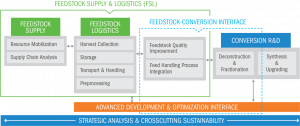WHAT IS BIOMASS?
As defined by the Energy Security Act (PL 96-294) of 1980, biomass is “any organic matter which is available on a renewable basis, including agricultural crops and agricultural wastes and residues, wood and wood wastes and residues, animal wastes, municipal wastes, and aquatic plants.”[1]
The following text introduces common biomass feedstocks as defined by the U.S. Department of Energy’s (DOE) Office of Energy Efficiency & Renewable Energy (EERE). “Terrestrial lignocellulosic biomass which includes plants and plant based materials not used for food, is an abundant, renewable, and sustainable resource for producing biofuels, bioproducts, and biopower.”[2]
Examples of biomass feedstocks include:
- Agricultural residues (e.g., corn stover)
- Algae
- Dedicated energy crops (e.g., switchgrass, miscanthus, energy cane, sweet sorghum, high biomass sorghum, hybrid poplars, and shrub willows)
- Forestry residues (e.g., logging residues and forest thinning)
- Waste streams and re-useable carbon sources (e.g., the non-recyclable organic portion of municipal solid waste, biosolids, sludges, waste food, plastics, C02, industrial waste gases, and manure slurries).[3]
The diagram below provides an overview of the FSL R&D scope and interface:

Source: Department of Energy, Office of Energy Efficiency and Renewable Energy (EERE)[4]

Comments are closed.